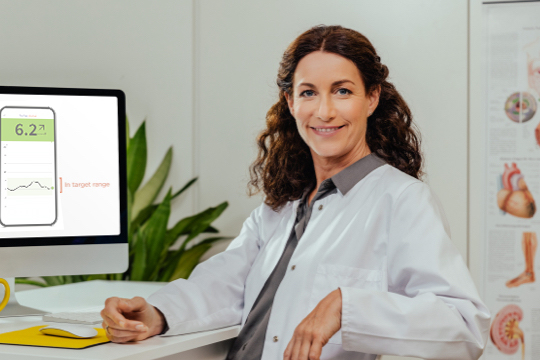Increased Monitoring Frequency
More frequent glucose monitoring with the FreeStyle Libre System is associated with better diabetes management1,5
Reduced HbA1c
Overall, 0.9% HbA1c reduction in patients with T2D on basal bolus insulin4
(p<0.0001)
43% increase in time in target range
(3.9-10 mmol) from 11.7 to 16.8 hours a day with increased scan rate5
(p<0.001)
63% reduction in time spent in hyperglycaemia
across patients with T1D and T2D5
(p<0.001)
43% reduction in time spent in hypoglycaemia
in patients with T2D3
(p<0.001)
Making Better Choices
The FreeStyle Libre portfolio helps patients with T2D make better choices
Real World data showed that 95% of patients with T1D and T2D using the FreeStyle Libre system:
✓ Have a better understanding of their glucose fluctuations10
✓ Data from FreeStyle Libre users with T2D showed that users feel more engaged with managing their diabetes3,4
Lifestyle modifications can help lower HbA1c
Patients with T2D who make lifestyle changes, such as diet and physical activity, see improved glucose control.8

Improve Glycaemic Control in ChildrenѰ
Children and teenagers can successfully improve their glycaemic control with the FreeStyle Libre system
Increased time in range by 1 hour/day9 (3.9-10 mmol)
Reduced HbA1c by 0.4%9
Increased the frequency of glucose monitoring to an average of 13x /day vs. SMBG9
Reduced time spent in hyperglycaemia
(>10 mmol) by 1 hr/day with no significant increase in time spent in hypoglycaemia (<3.9 mmol)9
90% of children and teenagers agreed that the FreeStyle Libre system did not get in the way of daily activities9
Additional Resources
Real-World Data
Analysing the impact of the FreeStyle Libre systems on the lives of real users.
References & Disclaimers
Images are for illustrative purposes only. Not real patient or data.
1. Dunn, T., et al. Real-world flash glucose monitoring patterns and associations between self-monitoring frequency and glycaemic measures: A European analysis of over 60 million glucose tests. Diabetes Research and Clinical Practice; 137(2018) 37-46
2. Bolinder J, Antuna R, Geelhoed-Duijvestijn P, Kröger J, Weitgasser R. Novel glucose-sensing technology and hypoglycaemia in type 1 diabetes: a multicentre, non-masked, randomised controlled trial. Lancet. 2016;388(10057):2254-2263.
3. Haak T, et al. Flash glucose-sensing technology as a replacement for blood glucose monitoring for the management of insulin-treated type 2 diabetes: a multicenter, open-label randomized controlled trial. Diabetes Ther 2017;8(1):55–73.
4. Kröger J, et al. Three European retrospective real-world chart review studies to determine the effectiveness of flash glucose monitoring on HbA1c in adults with type 2 diabetes. Diabetes Ther 2020;11(1):279–91.
5. Lang J, et al. Expanded real-world use confirms strong association between frequency of flash glucose monitoring and glucose control [Poster 972]. Diabetes 2019 Jun; 68(Supplement 1). https://doi.org/10.2337/db19- 972-P.
6. Evans E, Welsh Z, Ells S, Seibold A. The impact of flash glucose monitoring on glycaemic control as measured by HbA1c: a meta-analysis of clinical trials and real-world observational studies. Diabetes Ther. 2020;11(1):83-95
7. Yaron M, et al. Effect of flash glucose monitoring technology on glycemic control and treatment satisfaction in patients with type 2 diabetes. Diabetes Care 2019;42(7):1178–84.
8. American Diabetes Association Professional Practice Committee. 5. Facilitating behavior change and well-being to improve health outcomes: Standards of Medical Care in Diabetes—2022. Diabetes Care 2022;45 (Suppl. 1):S60–S82
9. Campbell FM, et al. Outcomes of using flash glucose monitoring technology by children and young people with type 1 diabetes in a single arm study.
Pediatr Diabetes 2018;19(7):1294–301.
10. Fokkert M, van Dijk P, Edens M, et al. Improved well-being and decreased disease burden after 1-year use of flash glucose monitoring (FLARE-NL4). BMJ Open Diab Res Care. 2019. https://doi:10.1136/bmjdrc-2019-000809
Ѱ. For children aged 4-12, a caregiver at least 18 years old is responsible for supervising, managing, and assisting them in using the FreeStyle Libre system and interpreting its readings.

